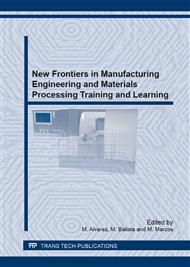p.47
p.55
p.63
p.73
p.83
p.91
p.101
p.113
p.121
Simulation Tools as an Educational and Training Resource in Manufacturing Engineering Subjects Teaching
Abstract:
Education & Learning Process at Manufacturing Engineering subjects requires the use, at every educational level, of resources and technologies that improve professor educative practice and student contents and competences acquisition. In this work it is showed the use of a 3D simulation tool for virtual models creation, carried out by National Distance University of Spain and the Salesianos Atocha School at Madrid, Spain, within the practical part of several subjects of their manufacture engineering studies and professional formative. It is analyzed and discussed the development of a virtual model that simulates a lathe gearbox manufacturing project in the classroom. A 3D CAD geometry is used as a base for the calculation and design of all the gearbox components (main spindle, chuck ́s joints, gears, change of feed, etc.). This methodology, used with every lathe component, permits the presentation of the machine as a whole and the analysis of the gearbox development in it. Human factors, assembly time, workplaces development and 3D lines design are studied and analyzed within the proposed model. The programs which have been used to develop this work are: Inventor 2009, Adobe Premier and 3D Studio Max R6. The final results can be displayed into several digital formats which help with the pedagogical model promotion.
Info:
Periodical:
Pages:
83-90
Citation:
Online since:
July 2013
Price:
Сopyright:
© 2013 Trans Tech Publications Ltd. All Rights Reserved
Share:
Citation:


